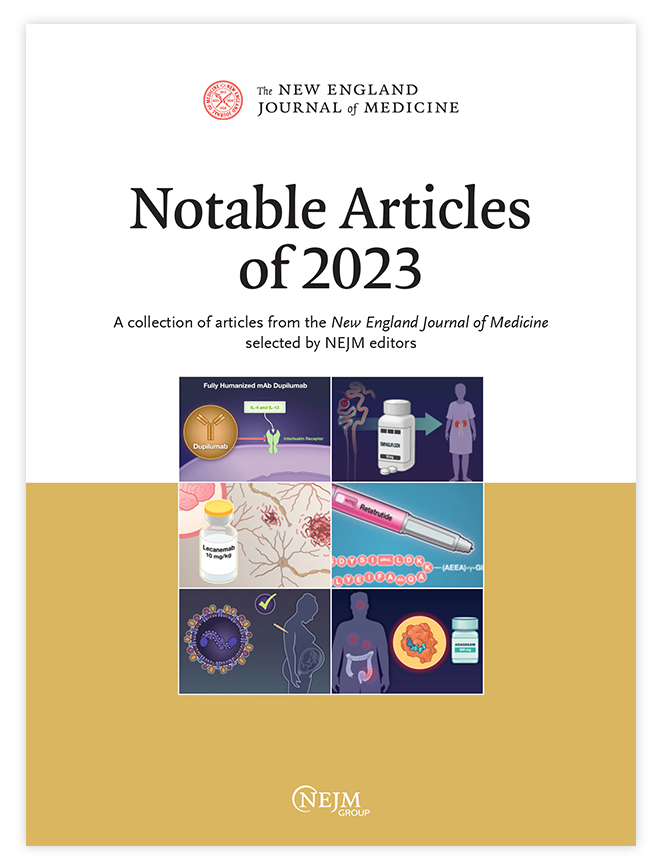Once-Monthly Maridebart Cafraglutide for the Treatment of Obesity - A Phase 2 Trial.
IF 78.5
1区 医学
Q1 MEDICINE, GENERAL & INTERNAL
引用次数: 0
Abstract
BACKGROUND Maridebart cafraglutide (known as MariTide) is a long-acting peptide-antibody conjugate that combines glucagon-like peptide-1 receptor agonism and glucose-dependent insulinotropic polypeptide receptor antagonism and that is intended for the treatment of obesity. METHODS We conducted a phase 2, double-blind, randomized, placebo-controlled, dose-ranging trial that included 11 groups as two cohorts. Participants with obesity (obesity cohort) were randomly assigned in a 3:3:3:2:2:2:3 ratio to receive maridebart cafraglutide subcutaneously at a dose of 140, 280, or 420 mg every 4 weeks without dose escalation; 420 mg every 8 weeks without dose escalation; 420 mg every 4 weeks with 4-week dose escalation; 420 mg every 4 weeks with 12-week dose escalation; or placebo. Participants with obesity with type 2 diabetes (obesity-diabetes cohort) were randomly assigned in a 1:1:1:1 ratio to receive maridebart cafraglutide at a dose of 140, 280, or 420 mg every 4 weeks (all without dose escalation) or placebo. The primary end point was the percent change in body weight from baseline to week 52. RESULTS We enrolled 592 participants. In the obesity cohort (465 participants; female sex, 63%; mean age, 47.9 years; mean body-mass index [BMI, the weight in kilograms divided by the square of the height in meters], 37.9), the mean percent change in body weight from baseline to week 52 on the basis of the treatment policy estimand (intention-to-treat approach) ranged from -12.3% (95% confidence interval [CI], -15.0 to -9.7) to -16.2% (95% CI, -18.9 to -13.5) with maridebart cafraglutide, as compared with -2.5% (95% CI, -4.2 to -0.7) with placebo. In the obesity-diabetes cohort (127 participants; female sex, 42%; mean age, 55.1 years; mean BMI, 36.5), the mean percent change in body weight from baseline to week 52 on the basis of the treatment policy estimand ranged from -8.4% (95% CI, -11.0 to -5.7) to -12.3% (95% CI, -15.3 to -9.2) with maridebart cafraglutide, as compared with -1.7% (95% CI, -2.9 to -0.6) with placebo. The mean change in the glycated hemoglobin level on the basis of the treatment policy estimand in this cohort was -1.2 to -1.6 percentage points in the maridebart cafraglutide groups and 0.1 percentage points in the placebo group. Gastrointestinal adverse events were common with maridebart cafraglutide, although less frequent with dose escalation and a lower starting dose. No unexpected safety signals emerged. CONCLUSIONS In this phase 2 trial, once-monthly maridebart cafraglutide resulted in substantial weight reduction in participants with obesity with or without type 2 diabetes. (Funded by Amgen; ClinicalTrials.gov number, NCT05669599.).每月一次的Maridebart Cafraglutide用于治疗肥胖- 2期试验。
背景:maridebart cafraglutide(被称为MariTide)是一种长效肽抗体偶联物,结合了胰高血糖素样肽-1受体激动作用和葡萄糖依赖性胰岛素性多肽受体拮抗剂,用于治疗肥胖。方法我们进行了一项2期、双盲、随机、安慰剂对照、剂量范围试验,包括11组作为两个队列。肥胖患者(肥胖队列)按3:3:3:2:2:2:3的比例随机分配,每4周皮下注射140、280或420 mg卡拉格鲁肽,剂量不增加;每8周420毫克,剂量不增加;每4周420毫克,4周剂量递增;每4周420毫克,12周剂量递增;或安慰剂。肥胖合并2型糖尿病的参与者(肥胖-糖尿病队列)按1:1:1:1的比例随机分配,每4周接受140、280或420 mg剂量的maridebart卡拉格鲁肽(均无剂量递增)或安慰剂。主要终点是从基线到第52周的体重变化百分比。结果我们招募了592名参与者。在肥胖组(465名参与者;女性占63%;平均年龄47.9岁;平均体重指数[BMI,体重以公斤为单位除以身高以米为单位的平方],37.9),根据治疗政策估计(意向治疗方法),体重从基线到第52周的平均百分比变化范围为-12.3%(95%可信区间[CI], -15.0至-9.7)至-16.2% (95% CI, -18.9至-13.5),而安慰剂组为-2.5% (95% CI, -4.2至-0.7)。在肥胖-糖尿病队列中(127名参与者;女性占42%;平均年龄55.1岁;平均BMI, 36.5),在治疗政策估计的基础上,体重从基线到第52周的平均百分比变化范围为-8.4% (95% CI, -11.0至-5.7)至-12.3% (95% CI, -15.3至-9.2),而安慰剂组为-1.7% (95% CI, -2.9至-0.6)。在该队列中,基于治疗政策估计的糖化血红蛋白水平的平均变化在maridebart cafraglutide组为-1.2至-1.6个百分点,在安慰剂组为0.1个百分点。胃肠道不良事件在maridebart卡拉格鲁肽中很常见,但随着剂量的增加和起始剂量的降低而减少。没有出现意外的安全信号。结论:在这项2期试验中,每月一次的maridebart cafraglutide可显著减轻伴有或不伴有2型糖尿病的肥胖患者的体重。(安进资助;ClinicalTrials.gov号码:NCT05669599)。
本文章由计算机程序翻译,如有差异,请以英文原文为准。
求助全文
约1分钟内获得全文
求助全文
来源期刊

New England Journal of Medicine
医学-医学:内科
CiteScore
145.40
自引率
0.60%
发文量
1839
审稿时长
1 months
期刊介绍:
The New England Journal of Medicine (NEJM) stands as the foremost medical journal and website worldwide. With an impressive history spanning over two centuries, NEJM boasts a consistent publication of superb, peer-reviewed research and engaging clinical content. Our primary objective revolves around delivering high-caliber information and findings at the juncture of biomedical science and clinical practice. We strive to present this knowledge in formats that are not only comprehensible but also hold practical value, effectively influencing healthcare practices and ultimately enhancing patient outcomes.
 求助内容:
求助内容: 应助结果提醒方式:
应助结果提醒方式:


